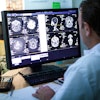
The COVID-19 pandemic has made existing healthcare disparities even more clear, with the brunt of morbidity and mortality being borne by minority patients, those with fewer financial resources, and those without insurance, according to an article published May 15 in Academic Radiology.
Healthcare inequality manifests in a variety of social determinants of health -- that is, "entrenched social inequities" -- and it shows up in the radiology department as well, wrote a team led by Dr. Peter Abraham of the University of California, San Diego.
"In radiology, social determinants of health lead to disparate use of imaging services through multiple intersecting contributors, on both the provider and patient side, affecting diagnosis and treatment," the researchers wrote. "Interventions designed to mitigate social determinants of health could help equalize the healthcare system."
Radiologists can examine and tackle disparities "perpetuated by our own departments and institutions," Abraham's team wrote. The authors outlined six issues that can lead to inequality in healthcare and offered suggestions for how to address them.
- Access to imaging. Minority patients often have lower rates of imaging, which could be due to provider bias, the group wrote. Offer radiology staff training to address this bias and implement stricter, race-neutral imaging guidelines.
- Appointment flexibility. Offer walk-in and flexible/extended appointment times to accommodate patients' work and childcare responsibilities.
- Communication. Limited language diversity in the radiology department can hinder communication with patients, according to the authors. Make translators available; retain bilingual staff. Distribute material to patients that outlines common procedures and provides decision support.
- Financial access/insurance. Lack of insurance or inadequate insurance influences whether patients undergo imaging services and are able to access advanced imaging, Abraham and colleagues wrote. Provide free or discounted screening exams and forgiving policies for lateness or missed appointments. Expand the list of accepted insurers and increase Medicare/Medicaid patient pool.
- Healthcare literacy. Patients may not understand the importance of screening exams or what they will undergo during a particular procedure, the team noted. Reach out to patients with illustrated decision support materials and improved communication between patients and providers.
- Transportation. Minority patients may have to travel farther for imaging. Help patients arrange for transportation and offer same-day exams and procedures (i.e., mammography screening and breast biopsy). Establish imaging centers in low socioeconomic areas.
Social determinants of health are built into the healthcare structure, and addressing them takes time and collaborative effort, according to Abraham and colleagues.
"Equity within radiology and healthcare, in general, cannot be achieved without cooperated, wide-scale efforts to address disparities in social determinants of health," they wrote. "Radiologists can help by addressing factors contributing to differential screening and intervention in order to provide all patients with the best possible care."




















